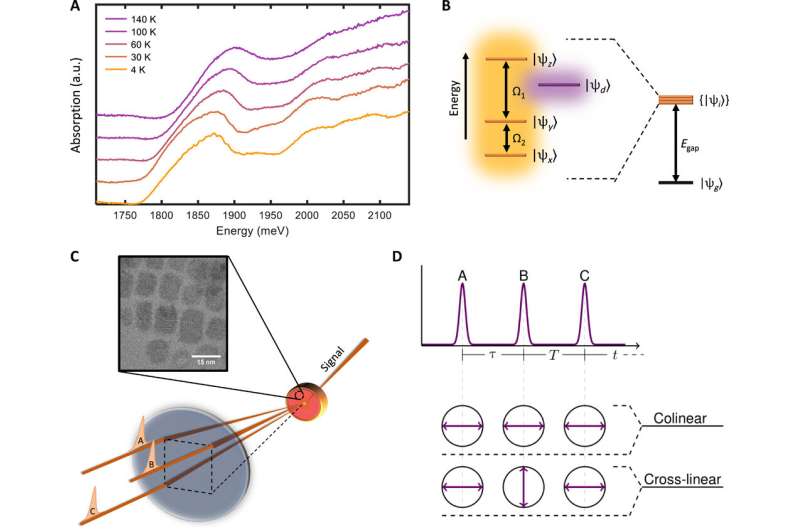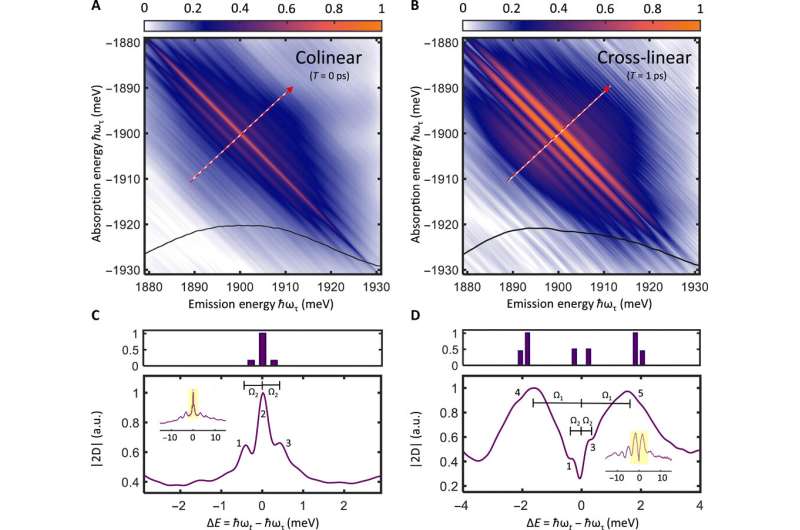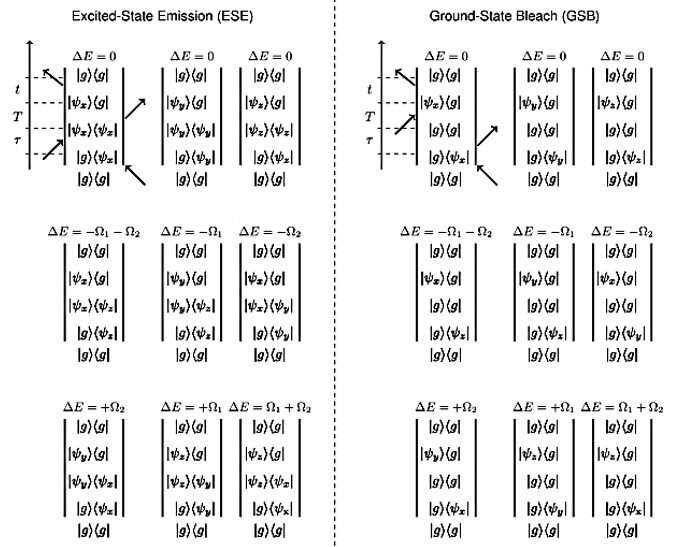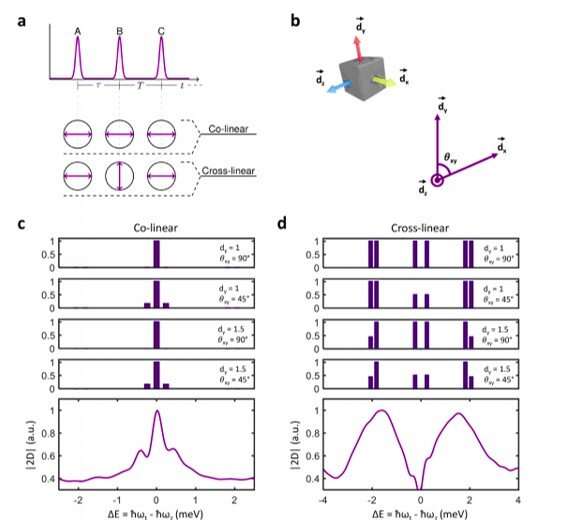CsPbI3 perovskite NCs studied via MDCS. (A) Perovskite NC absorption spectra as a function of temperature. (B) Energy level diagram of the nondegenerate bright triplet states {Ψi = x,y,z} that comprise the band-edge transitions to and from |Ψg⟩. The dark singlet state |Ψd⟩ is shown to lie between states |Ψy⟩ and |Ψz⟩. (C) Schematic of the MDCS experiment. Three pulses {A,B,C} are focused onto the sample with varying time delays. Inset shows a transmission electron micrograph of representative CsPbI3 NCs. (D) Excitation pulse sequence and excitation polarization schemes used to acquire one-quantum and zero-quantum spectra, in which double-sided arrows in circles denote the polarization of each pulse. Pulses A and C are horizontally polarized, and pulse B is either horizontally or vertically polarized, which corresponds to an emitted signal of either horizontal or vertical polarization respectively. a.u., arbitrary units. Credit: Science Advances, doi: 10.1126/sciadv.abb3594
Advanced optoelectronics require materials with newly engineered characteristics. Examples include a class of materials named metal-halide perovskites that have tremendous significance to form perovskite solar cells with photovoltaic efficiencies. Recent advances have also applied perovskite nanocrystals in light-emitting devices. The unusually efficient light emission of cesium lead-halide perovskite may be due to a unique excitonic fine structure made of three bright triplet states that minimally interact with a proximal dark singlet state. Excitons are electronic excitations responsible for the emissive properties of nanostructured semiconductors, where the lowest-energy excitonic state is expected to be long lived and hence poorly emitting (or 'dark').
In a new report now published in Science Advances, Albert Liu and a team of scientists in physics and chemistry at the University of Michigan, U.S., and Campinas State University, Brazil, used multidimensional coherent spectroscopy at cryogenic (ultra-cold) temperatures to study the fine structure without isolating the cube-shaped single nanocrystals. The work revealed coherences (wave properties relative to space and time) involving the triplet states of a cesium lead-iodide (CsPbI3) nanocrystal ensemble. Based on the measurements of triplet and inter-triplet coherences, the team obtained a unique exciton fine structure level ordering composed of a dark state, energetically positioned within the bright triplet manifold.
Constructing an ensemble of cesium lead-halide nanocrystals
In this work, Liu et al. extracted crucial figures of information processing to construct an ensemble of cesium lead-iodide nanocrystals (CsPbI3) at cryogenic temperatures. The first synthetic cesium lead-halide perovskites were developed more than a century ago with a general chemical formula of CsPbX3 (where X= chlorine—Cl, bromine—Br, or Iodine—I) and a recent production formed CsPbX3 nanocrystals that combined the advantages of perovskites with those of colloidal nanocrystal materials. The perovskite nanocrystals exhibited luminescence with quantum yield to reach nearly unity in contrast to chalcogenide nanocrystals with a gradient shell.
Optical triplet coherences in one-quantum spectra. (A and B) Magnitude one-quantum spectrum at 4.6 K with (A) colinear and (B) cross-linear excitation. The white/red dashed arrows and solid black lines indicate the cross-slice locations and laser pulse spectra, respectively. (C and D) Bottom plots show normalized cross-slices centered at |ħωτ| = |ħωt| = 1900 meV of the (C) colinear and (D) cross-linear excitation one-quantum spectrum. Top plots show theoretically calculated relative peak strengths in the NC reference frame (see the Supplementary Materials). Numbers label peaks arising from electronic interband coherences and populations. Credit: Science Advances, doi: 10.1126/sciadv.abb3594
The unusual brightness of perovskite nanocrystals originated from an optically active, non-degenerate triplet state that emits efficiently despite the presence of a dark singlet state. The unique exciton fine structures of perovskite nanocrystals improved the potential of colloidal nanocrystals for quantum information processing applications. However, researchers require intimate knowledge of the coherent dynamics in perovskite nanocrystals to engineer the exciton superposition states as information carriers, which were not well understood. Liu et al. therefore used multidimensional coherent spectroscopy to measure the triplet state excitons and presented evidence for a mixed bright-dark level ordering, which rendered the triplet state excitons to only be partially bright. The team then used perovskite nanocrystals as a potential material platform for quantum applications through bottom-up engineering methods.
Triplet state quantum pathways and Feynman diagrams
To conduct multidimensional coherent spectroscopy, the team used a multidimensional optical nonlinear spectrometer that focused three laser pulses on to the perovskite nanocrystal ensemble as a function of three different time delays (τ, T, and t). During the experiments, the scientists Fourier transformed the emitted four-wave mixing signal as a function of two or all three of the time delays in a multidimensional spectrum. They commonly referred to the resulting sequences of light-matter interactions as quantum pathways. The team conceptually represented the quantum pathways using double-sided Feynman diagrams. The diagrams contained vertically arranged sequences of density matrix elements that began with an initial ground state population where time advanced upward, with changes introduced in the density matrix by interactions with each excitation pulse. They noted three types of quantum pathways defined as "excited-state emission" (ESE), "ground-state bleach" (GSB) and "excited-state absorption" (ESA), and only considered ESE and GSB pathways during this work.
Double-sided Feynman diagrams of quantum pathways. Double-sided Feynman diagrams representing accessible quantum pathways in perovskite nanocrystals. Nine ESE and GSB diagrams each are possible, which involve an intermediate excited-state population/coherence and ground-state population respectively. The peak position of each diagram in one-quantum spectra is labeled above. Credit: Science Advances, doi: 10.1126/sciadv.abb3594
Fourier transforming studies had previously revealed new electronic properties of various perovskite materials. In order to experimentally probe different quantum pathways, the team chose the polarization of the second laser pulse in the setup to either align parallelly or orthogonally to the collinear polarization of the two other pulses. They obtained a single-quantum spectrum at a temperature of 4.6 K with colinear and cross-linear excitation. The spectra revealed numerous peaks elongated in the diagonal direction to reflect inhomogeneous spectral broadening. To explain the peak structure for both excitation polarization schemes, Liu et al. theoretically calculated the relative peak strengths for the varying dipole matrix elements and vector orientations of each triplet state transition and drew important conclusions from the calculations. Compared to the integrated four-wave mixing techniques, one-quantum spectra was particularly useful in this work.
Peak strength calculations. (A) Excitation polarization sequences as described. (B) Schematic of dipole moment vector orientations, in which
Terahertz inter-triplet coherences in zero-quantum spectra
Liu et al. next showed many of the quantum pathways to generate sidebands relative to inter-triplet coherences, i.e., quantum coherences between triplet states that are not necessarily dipole-coupled. The inter-triplet coherence time defined the time scale within which the involved super-position states could be coherently manipulated in the experimental setup, which was of practical importance. To directly measure and characterize these coherences, the team used zero-quantum spectra at varying time delays and temperatures (τ = 0 and 20 K). For cross-linear excitation, the researchers isolated the inter-triplet coherence pathways by passing the measured four-wave mixing signal through a vertical polarizer to plot a resulting cross-linear, zero-quantum spectrum at 20 K. The inter-triplet coherences were robust against thermal dephasing (up to 40 K) and the work also showed the electronic nature of the four-wave mixing signal.
Terahertz inter-triplet coherences in zero-quantum spectra. (A) Magnitude zero-quantum spectrum taken at τ = 0 fs and 20 K. Two sidebands due to inter-triplet coherences are observed. (B) Evolution of normalized slices taken along the dashed red line in (A) at ħωτ = 1890 meV as a function of delay τ (at 20 K) and temperatures [10, 15, 20, 25, 30, 40] K (at τ = 0 fs). (C) Fit of normalized cross-slice taken at τ = 0 fs, in which the complex Lorentzians of peaks 6 and 8 are shifted by phases −π/2 relative to peak 7. The shaded curves represent the real quadratures of each Lorentzian in the fit line shape, and the top plot is the phase of the fitted complex line shape. Credit: Science Advances, doi: 10.1126/sciadv.abb3594
In this way, Albert Liu and colleagues measured and characterized the optical frequency triplet coherences and inter-triplet coherences in perovskite lattices. The results were significantly different from those previously reported for other lead-halide nanocrystals. It appears that even a slight change in a single constituent atom of the perovskite lattice could drastically alter the interactions that determined the fine structural-level ordering, which warrants further investigation. The team experimentally and theoretically presented evidence of an exciton band edge whose emission is partially quenched by an intermediate dark state to contribute important insight to the exciton ground states in a variety of perovskite nanocrystals with potential applications for quantum information processing.
More information: Liu A. et al. Multidimensional coherent spectroscopy reveals triplet state coherences in cesium lead-halide perovskite nanocrystals, Science Advances, 10.1126/sciadv.abb3594
Becker M. A. et al. Bright triplet excitons in caesium lead halide perovskites. Nature, doi.org/10.1038/nature25147
Tamarat P. et al. The ground exciton state of formamidinium lead bromide perovskite nanocrystals is a singlet dark state. Nature Materials, doi.org/10.1038/s41563-019-0364-x
Journal information: Science Advances , Nature , Nature Materials
© 2021 Science X Network




![Terahertz inter-triplet coherences in zero-quantum spectra. (A) Magnitude zero-quantum spectrum taken at τ = 0 fs and 20 K. Two sidebands due to inter-triplet coherences are observed. (B) Evolution of normalized slices taken along the dashed red line in (A) at ħωτ = 1890 meV as a function of delay τ (at 20 K) and temperatures [10, 15, 20, 25, 30, 40] K (at τ = 0 fs). (C) Fit of normalized cross-slice taken at τ = 0 fs, in which the complex Lorentzians of peaks 6 and 8 are shifted by phases −π/2 relative to peak 7. The shaded curves represent the real quadratures of each Lorentzian in the fit line shape, and the top plot is the phase of the fitted complex line shape. Credit: Science Advances, doi: 10.1126/sciadv.abb3594 Multidimensional coherent spectroscopy reveals triplet state coherences in cesium lead-halide perovskite nanocrystals](https://scx1.b-cdn.net/csz/news/800a/2021/4-multidimensi.jpg)























